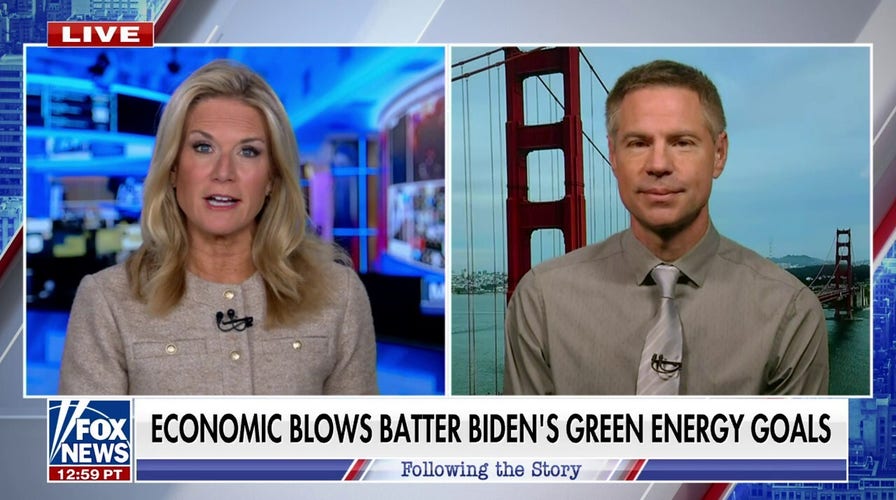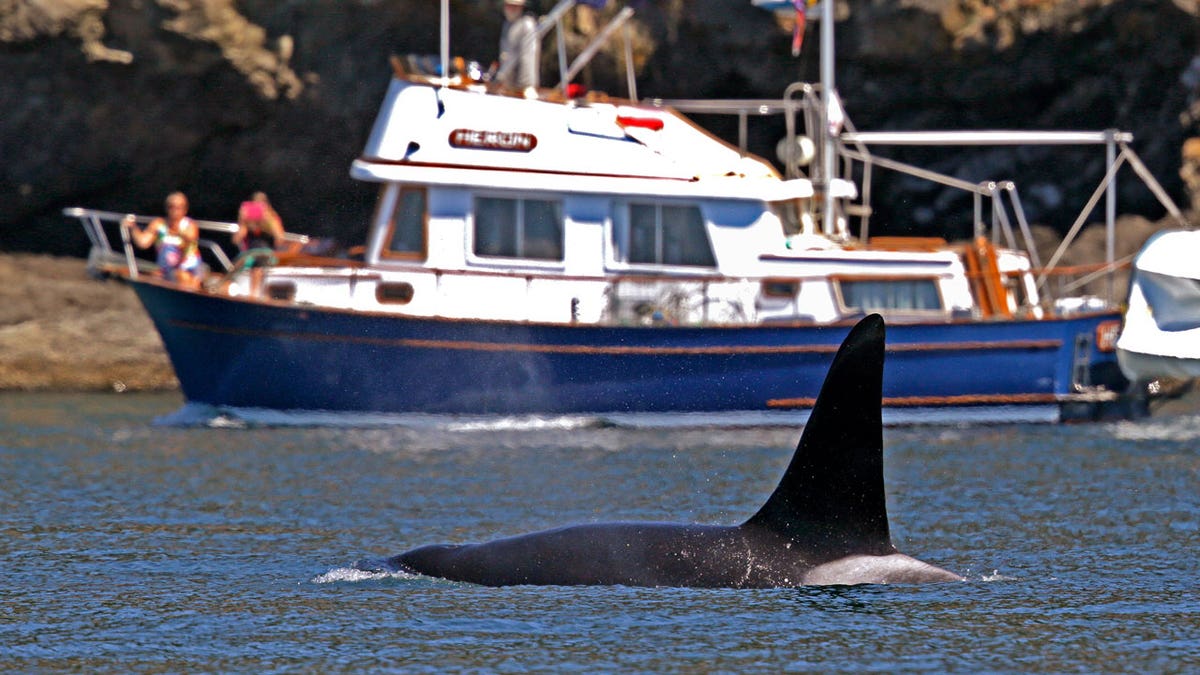close 
We need to protect these whales: Journalist Michael Shellenberger
Journalist Michael Shellenberger provides insight on how President Biden’s green energy goals sparks concerns for animal life on ‘The Story with Martha MacCallum.’
Photographer Matt McDonald had lived on Puget Sound for years, but had never seen a whale, so he was elated when he spotted a giant marine mammal just off Seattle’s waterfront one evening.
The excitement was short-lived. As McDonald tracked the whale in his camera’s viewfinder, a state ferry that dwarfed the animal came into the frame. The next morning he saw on the news that the humpback whale had died in the collision he witnessed.
“I still remember the moment of when they crossed paths and my heart just sinking like, ‘Oh my God, the ferry just ran over the whale,'” he recalled of the 2019 encounter. “I wish there was something I could have done.”
NORTH ATLANTIC RIGHT WHALE FOUND DEAD OFF GEORGIA COAST MARKS SECOND RECENT DEATH OF ENDANGERED SPECIES
Now, five years later, there is.
The U.S. Coast Guard has launched a pilot program to alert ships of whale sightings in Washington state’s Salish Sea. The goal of the agency’s “cetacean desk” is to keep the marine mammals safe from boat strikes and reduce noise in the highly transited inland seawaters.
The program, which began official operations in December, comes at a time when visits by humpback whales and sea mammal-hunting orcas increase as their populations rebound.

An orca swims past a recreational boat sailing just offshore in the Salish Sea in the San Juan Islands, Wash., July 31, 2015. The U.S. Coast Guard is launching a pilot program to alert vessels of whale sightings to help keep the mammals safe from boat strikes and noise. (AP Photo/Elaine Thompson, File)
Fed by the Pacific Ocean, the Salish Sea is a maze of islands and canals that make up the inland waters between Washington state and British Columbia, including Puget Sound. Two groups of orcas — one that preys on salmon and the other on sea mammals — as well as baleen whales have cruised these waters since time immemorial and are now often visible from Seattle’s shoreline.
But these waters are now also home to major American and Canadian ports, and nearly 300,000 vessels crisscrossed the area in 2023, from commercial container ships to cruise ships to ferries, according to the Coast Guard. That doesn’t include private crafts.
The new whale desk reduces the risk of collisions by combining sightings by mariners and civilians on whale-watching apps and data from underwater listening devices into an integrated system that will send out alerts to commercial vessels and regional ferries through a mobile app. The alerts will not go out to private or recreational boats.
“We’re focusing on empowering the ship operators with the situational awareness … so they’re able to slow down preemptively, perhaps give a little bit of a wider berth to an area with a recently reported whale,” said Lt. Commander Margaret Woodbridge, who is managing the whale desk.
The Salish Sea is an “incredible area that has a lot of a rich diversity of whale species here,” Woodbridge added. “And also a lot of economic activity on the waterways. And so we’re really trying to help both thrive.”
People who spot whales can download one of two apps that will feed into the Coast Guard’s Puget Sound Vessel Traffic Service. Mariners can use radio frequencies and a phone tip line when they spot whales. Participation in the program is voluntary for ships.
The whale desk is modeled to match the Canadian Coast Guard’s “Marine Mammal Desk.” Both American and Canadian desks are built on the backbone of the Whale Report Alert System (WRAS), a program developed by Canada-based Ocean Wise, that incorporates sightings from individuals, apps and other sources, such as private tracking information used by whale watching boats.
The Salish Sea’s four-year pilot program, initially prompted for the wellbeing of endangered Southern Resident Killer Whales, is the culmination of years of work by wildlife advocates, the maritime industry and state and federal agencies. It was created after U.S. Sen. Maria Cantwell sponsored it in the 2022 Coast Guard Authorization Act.
“It’s really a bit of a watershed moment,” Kevin Bartoy, who has been chief sustainability officer for Washington state ferries for about a decade, said of the alert system.
“The amount of sightings now that we get on any given day is incredible. We can know essentially where a whale is at any time.”
The collision between the humpback whale and the ferry was shocking for Bartoy, but it underlined the need for a widely-used and available alert system. He said the ferry system had already joined WRAS but it wasn’t widely used in Washington then. The day of the 2019 collision there had been only one alert of a whale in the area, he said.
Now the more integrated network has resulted in an exponential increase of sightings. Woodbridge, of the Coast Guard, said reports spiked by 585% when comparing December 2022 and December 2023 when the desk launched and now that WRAS has sightings from the apps.
But work is not done. The whale desk is currently mostly based on what people can see, leaving spotting the animals at night and in inclement weather much harder.
Bartoy said studies are underway in Canada and Washington to start testing land-basedthermal cameras that could potentially spot whales at night by seeking their warmth in the waters as well as a more robust underwater listening — or hydrophone — system to pick up whale songs.
John Calambokidis, senior biologist at the Cascadia Research Collective, said baleen whales, like humpbacks, are especially susceptible to ship collisions at night because they spend twice as much time near the surface then.
CLICK HERE TO GET THE FOX NEWS APP
Another way to keep whales safe is to adjust shipping lanes where possible, said Calambokidis. Through tagging, biologists know where humpback whale routinely congregate, but shifting shipping lanes is not currently being widely discussed, he said.
Late last year, a young humpback whale visited the waters off Seattle for several days and its visit provided an excellent example of what can happen when ship operators work together, said Jeff Hogan, formerly of the Soundwatch Boater Education Program.
Hogan shadowed the humpback as it breached, and ferries and other boaters adjusted their routes in real time to steer clear of the young whale, he said.
“The fact that the Coast Guard is watching elevates everyone’s behavior,” Hogan said. “It sets a standard of responsibility.”
